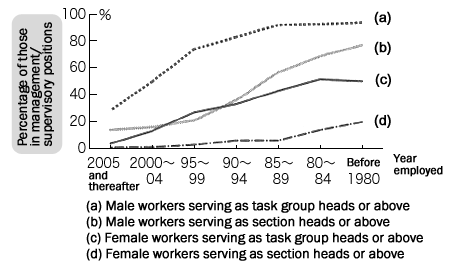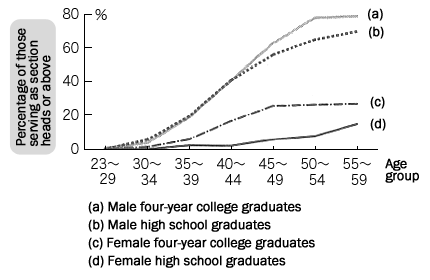Although the government plans to increase the ratio of women in leadership positions in the political and economic spheres to 30% by 2030, progress in women's advancement remains extremely slow in Japan. Among the member countries of the Organisation for Economic Co-operation and Development (OECD), the United States has a high percentage of women in management positions at 43%, while European countries mostly fall in the 30% to 40% range. In contrast, women account for approximately 10% of management positions in Japan. In this article, I would like to explore why the percentage of women in management positions remains low in Japan.
♦ ♦ ♦
A questionnaire survey of employers conducted by the Ministry of Health, Labour and Welfare (MHLW) identified three major reasons why Japanese companies have few or no women in management positions. The biggest reason, cited by the majority of respondent companies, is: "At the moment, we do not have any qualified women with sufficient knowledge, expertise, and judgment." Meanwhile, the second and third biggest reasons—"Although we have some female candidates for future management positions, at the moment, none of them meet the qualifications such as the number of years of service" and "The length of service of female employees tends to be short, and they usually leave before reaching managerial positions"—point to the short length of service of women. That is, Japanese companies see women as lacking experience. But is this true?
Figure 1 illustrates gender inequality among white-collar workers in full-time permanent employment based on my analysis of data from the 2009 survey on work-life balance conducted by the Research Institute of Economy, Trade and Industry (RIETI) and published in my article for the July 2014 issue of the Japanese Journal of Labour Studies. It shows that the percentage of those holding managerial and supervisory positions is significantly lower for women than men even when we compare those with the same length of service. Among female workers with 31 years or more of service, 20% were in positions of section heads (kacho) or above, whereas the same ratio of section heads were achieved by male workers only after 11 to 15 years of service. With regard to the proportion of those serving as task group heads (kakaricho) or above, the level achieved by women only after 31 years or more of service (50%) was reached by men within six to 10 years of service.

However, this analysis is subject to criticism in that it has not taken into account gender inequality in education. Indeed, two-year junior college was once the highest level of education completed for many women, with the proportion of four-year college graduates among the female workforce being significantly lower than that among the male workforce. Figure 2 below is a response to this criticism.

Surprisingly, the proportion of those serving as section heads or above among male high school graduates is significantly higher than that among female four-year college graduates. In sociology, a society in which individuals' social opportunities are determined by ascriptive attributes such as gender and race is called a pre-modern society, whereas one in which such opportunities are determined by achievements such as education is called a modern society. In this regard, Japan cannot be considered a modern society.
In the United States, for instance, educational qualifications, such as bachelor's degrees and master's degrees in business administration (MBA), are what count most in getting promoted to managerial positions regardless of gender. My analysis in the aforementioned article found that in Japan, only 30% of the gender inequality in the proportion of those serving as task group heads or above can be explained by the differences between men and women in educational attainment, age, and the number of years of service. This percentage is as low as 21% when it comes to ender inequality in the proportion of those serving as section heads or above.
♦ ♦ ♦
Other factors explaining gender inequality include work hours, in particular, whether the typical number of hours worked per week is above or below 49 hours. The difference in working hours is a powerful additional explanatory factor for gender inequality—43% of the inequality in the proportion of those serving as task group heads or above and 39% of the inequality in the proportion of section heads or above can be attributed to the difference in working hours, age, educational attainment, and length of service. Furthermore, the correlation between longer work hours and an increase in percentage of those holding managerial/supervisory positions is stronger for women than for men.
In relation to this fact, recent research by Professor Takao Kato of Colgate University, Professor Daiji Kawaguchi of Hitotsubashi University, and Professor Hideo Owan of the University of Tokyo, in which they analyzed panel data from personnel records of Japanese companies, found the following two important facts.
First, working long hours does not necessarily increase the probability of promotion for men but has a significant impact on the odds of promotion for women. This suggests that long work hours are a requisite for promotion to managerial/supervisory positions only for women. Second, higher performance evaluation increases the probability of promotion for men but not for women. This is considered to be the result of indirect discrimination in which women are assigned to positions with fewer chances for promotion regardless of the result of performance evaluation.
Discrimination against women through job assignment was commonplace in the United States in the 1970s, but such practices have become almost absent today owing partly to strict laws and regulations prohibiting indirect discrimination. However, a degree of occupational segregation attributable to gender differences in the choices of jobs still remains, contributing to wage disparities between men and women.
I have been advocating the importance of creating a society where adequate work-life balance is attainable as a way to promote women's advancement in economic activities. Because of a lack of work-life balance, more than 60% of Japanese female workers leave their jobs for marriage and childrearing. If they return to the workforce, the majority of them can only find jobs with a short-term contract that offer no prospects for career development because full-time jobs with an indefinite-term contract are saved primarily for new graduates. Furthermore, the current situation constitutes a self-fulfilling prophecy, in which the practice of not treating female workers as equals to their male counterparts by reason of the high likelihood of women quitting in a relatively short period of time deprives women of their willingness to continue to work, leading to a higher turnover rate for women.
♦ ♦ ♦
This time around, it has been found that long hour works are regarded as an essential prerequisite for promotion to management positions only for women, a practice that is contradictory to the attainment of adequate work-life balance. When evaluated against the criteria based on the length of work hours rather than on performance, women have little chance to get promoted to managerial positions. The root cause of a lack of work-life balance is the fact that working women are forced to bear the dual burden of work and family responsibilities because of the traditional gendered division of labor within the family, i.e., the husband as the breadwinner and the wife as the homemaker with primary childrearing responsibilities. Currently, that dual burden is particularly heavy on women in managerial/supervisory positions at Japanese workplaces.
Furthermore, apart from the lack of work-life balance, the presence of a major obstacle becomes apparent. By this, I am referring to what can be described as the "traditional division of labor within the organization" or the stereotypical notion that men are fit for leadership roles and women for supporting roles.
Because of this notion, personnel decisions, which should be based on the "right person for the right job regardless of gender" principle, are significantly affected by gender considerations for personnel matters. Indeed, various implicit gender-biased practices remain rampant in Japan, as seen in the so-called "course system" that effectively excludes the large majority of women from candidates for managerial/supervisory positions by employing them as ippanshoku (general staff) as well as in the customary practice of assigning men to line positions that offer greater chances of getting promoted to managerial/supervisory positions, and of assigning women—even highly capable ones—to staff positions that have lower chances. It is perceived that these practices have been hampering women's promotion to managerial/supervisory positions and participation in decision-making processes in their organizations.
The result is the current state of affairs—i.e., women do not get promoted even if their performance is highly rated and male high school graduates have better chances of getting promoted to managerial/supervisory positions than female four-year college graduates—that is quite abnormal by international standards. In order to promote women's advancement in economic activities, it is necessary to fundamentally change such traditional gendered division of labor within organizations. It is also crucial to prohibit by law all forms of indirect gender discrimination that are already in place.
In Japan, the 2006 amendment of the equal employment opportunity law provided for indirect discrimination. However, institutions and practices such as the "course system" which clearly have disparate impact on women are not regarded as indirect discrimination, contrary to the Convention on the Elimination of All Forms of Discrimination against Women (CEDAW), which Japan has ratified, as well as to the relevant laws and regulations in the United States and the European Union. Indeed, the Supreme Court of Japan has given its endorsement to gender inequality in promotion. In response to a hypothetical question as to whether an eight-to-two ratio of male to female employees among those promoted constitutes unreasonable discrimination provided that they joined the company in the same year or that they belong to the years-of-service groups to which the same base salary applies, a 2012 notice from the General Secretariat of the Supreme Court states as follows: "The overall ratio of male to female employees among those promoted per se does not constitute sufficient evidence for the presence of unreasonable discrimination."
In the United States, a measure for discrimination known as the "80% rule" has been established, whereby institutions or practices will be considered to have disparate impact on females if the rate for women in hiring or promotion is less than 80% of the rate for men with equivalent qualifications. As an additional measurement, it has also adopted the "significance rule" to regard the presence of statistically significant disparities as such evidence even when the 80% rule is satisfied. Companies not in conformity with those rules could be liable for damages unless they are able to provide justifiable reasons for their institutions and practices.
Judicial interpretations and conventional notions concerning indirect discrimination in Japan are a significant deviation from those in the rest of the world. Japanese companies should voluntarily abolish their practice of indirect discrimination. At the same time, it is strongly desired that relevant legislative changes will be made to promote women's advancement.
* Translated by RIETI.
August 29, 2014 Nihon Keizai Shimbun


